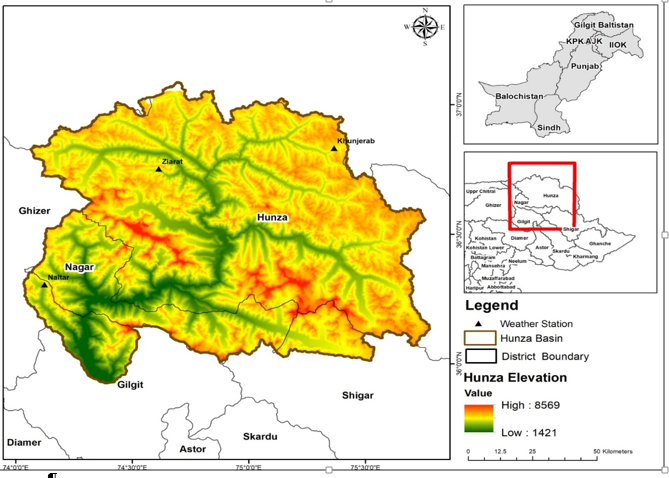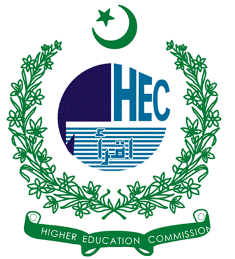Spatio-Temporal Estimation of Glacier Dynamics under Climate Change Scenarios Using Machine Learning Techniques
Keywords:
Glacier Dynamics, Machine Learning (ML), Random Forest (RF), Artificial Neural Network (ANN), Support Vector Machine (SVM), Climate ChangeAbstract
Glaciers of the Upper Indus Basin (UIB) play a vital role in providing water resources, hydropower generation, and livelihood, but they are very vulnerable and sensitive to continuous climate change impacts. This research presents a novel approach for accurate mapping of glacier extent, clean ice, debris cover, seasonal snow, and glacier melt across the Hunza Basin. We have used Grey Level Co-occurrence Matrix (GLCM), Machine Learning (ML) techniques of Random Forest (RF), Artificial Neural Networks (ANN), and Support Vector Machines (SVM) to conduct the purposeful research. ML models were trained on multispectral (Landsat, Sentinel-1 & 2, MODIS, and SPOT-5 from the last 35 years) and textural datasets. Overall, 6628 samples for training and 988 samples for testing were used to maintain a 70/ 30 ratio to evaluate overall accuracy (OA) and kappa coefficient (k̂). RF ensured the best results (OA = 95.4 %, k̂ = 0.965) in comparison of ANN (OA = 94%, k̂ = 0.92) and SVM (OA = 92 %, k̂ = 0.89). The accuracy of clean ice and seasonal snow remained consistent (producer accuracy and user accuracy >93%) compared to that of debris cover and glacier melt. Glacier retreat, increased ablation, formation of clean ice loss, and frequency of supraglacial melt due to expansion of debris cover up to 23.31% were witnessed spatially in the basin. Proposed approaches prove that ML techniques are very useful for the estimation of risk assessment in the climate-prone mountain basins and offer a robust way forward for hydrological modelling, glacier change monitoring, and water resource management.
References
B. Pradhan and B. Shrestha, B. “31 Global changes and sustainable development in the Hindu Kush–Karakoram–Himalaya,” Dev. Earth Surf. Process., vol. 10, pp. 281–290, 2007, doi: https://doi.org/10.1016/S0928-2025(06)10031-0.
K. F. Ali and D. H. De Boer, “Spatial patterns and variation of suspended sediment yield in the upper Indus River basin, northern Pakistan,” J. Hydrol., vol. 334, no. 3–4, pp. 368–387, 2007, doi: https://doi.org/10.1016/j.jhydrol.2006.10.013.
S. W. Sonam Rinzin,Guoqing Zhang, “Glacial Lake Area Change and Potential Outburst Flood Hazard Assessment in the Bhutan Himalaya,” Front. Earth Sci, vol. 9, 2021, doi: https://doi.org/10.3389/feart.2021.775195.
Gao, H., Zou, X., Wu, J. et al. “Post-20th century near-steady state of Batura Glacier: observational evidence of Karakoram Anomaly,” Sci Rep, vol. 10, 2020, doi: https://doi.org/10.1038/s41598-020-57660-0.
A. A. Madhav Prasad Dhakal, Amjad Ali, Muhammad Zafar Khan, Nisha Wagle, Ghulam Muhammad Shah, Muhammad Mudassar Maqsood, “Agricultural water management challenges in the Hunza River Basin: Is a solar water pump an alternative option?*,” Irrig. Drain., 2021, doi: https://doi.org/10.1002/ird.2563.
A. Mukhopadhyay, B., Dutta, “A Stream Water Availability Model of Upper Indus Basin Based on a Topologic Model and Global Climatic Datasets,” Water Resour Manag., vol. 24, pp. 4403–4443, 2010, doi: https://doi.org/10.1007/s11269-010-9666-0.
F. M. Khan Garee, Xi Chen, Anming Bao, Yu Wang, “Hydrological Modeling of the Upper Indus Basin: A Case Study from a High-Altitude Glacierized Catchment Hunza,” Water, vol. 9, no. 1, p. 17, 2017, doi: https://doi.org/10.3390/w9010017.
K. A. Alam F, Rahman SU, Khusro S, Ullah S, “Evaluation of Medical Image Registration Techniques Based on Nature and Domain of the Transformation,” J Med Imaging Radiat Sci, vol. 47, no. 2, pp. 178–193, 2016, doi: 10.1016/j.jmir.2015.12.081.
“AR5 Climate Change 2013: The Physical Science Basis — IPCC.” Accessed: Apr. 13, 2022. [Online]. Available: https://www.ipcc.ch/report/ar5/wg1/
IPCC, “Climate Change 2013: The Physical Science Basis. Contribution of Working Group I to the Fifth Assessment Report of the Intergovernmental Panel on Climate Change,” Cambridge Univ. Press, 2013.
R. Farhan, S. B., Zhang, Y., Aziz, A., Gao, H., Ma, Y., Kazmi, J., Shahzad, A., Hussain, I., Mansha, M., Umar, M., Nasir, J., Shafiq, M., Farhan, Y., Shaikh, S., Zamir, U. B., Asad, F., & Ahmed, “Assessing the impacts of climate change on the high altitude snow and glacier fed hydrological regimes of Astore and Hunza, the sub-catchments of Upper Indus Basin,” J. Water Clim. Chang., vol. 11, no. 2, pp. 479–490, 2018, doi: https://doi.org/10.2166/wcc.2018.107.
W. W. Immerzeel, F. P. & M. F. P. B. “Rising river flows throughout the twenty-first century in two Himalayan glacierized watersheds,” Nat. Geosci., vol. 6, pp. 742–745, 2013, [Online]. Available: https://www.nature.com/articles/ngeo1896
A. A. Tahir, P. Chevallier, Y. Arnaud, and B. Ahmad, “Snow cover dynamics and hydrological regime of the Hunza River basin, Karakoram Range, Northern Pakistan,” Hydrol. Earth Syst. Sci., vol. 15, no. 7, pp. 2275–2290, 2011, doi: 10.5194/HESS-15-2275-2011.
Hayat, H., Tahir, A. A., Wajid, S., Abbassi, A. M., Zubair, F., Hashmi, Z. ur R., … Irshad, M. “Simulation of the meltwater under different climate change scenarios in a poorly gauged snow and glacier-fed Chitral River catchment (Hindukush region),” Geocarto Int., vol. 37, no. 1, pp. 103–119, 2019, doi: https://doi.org/10.1080/10106049.2019.1700557.
Hayat, H.; Akbar, T.A.; Tahir, A.A.; Hassan, Q.K.; Dewan, A.; Irshad, M. “Simulating Current and Future River-Flows in the Karakoram and Himalayan Regions of Pakistan Using Snowmelt-Runoff Model and RCP Scenarios,” Water, vol. 11, no. 4, p. 761, 2019, doi: https://doi.org/10.3390/w11040761.
Hao, M., Li, Y. & Zhuang, W. “Crustal movement and strain distribution in East Asia revealed by GPS observations,” Sci Rep, vol. 9, p. 16797, 2019, doi: https://doi.org/10.1038/s41598-019-53306-y.
A. Mir, R. A., Jain, S. K., Saraf, A. K., & Goswami, “Accuracy assessment and trend analysis of MODIS-derived data on snow-covered areas in the Sutlej basin, Western Himalayas,” Int. J. Remote Sens., vol. 36, no. 15, pp. 3837–3858, 2015, doi: https://doi.org/10.1080/01431161.2015.1070320.
A. E. Tekeli, Z. Akyürek, A. A. Şorman, A. Şensoy, and A. Ünal Şorman, “Using MODIS snow cover maps in modeling snowmelt runoff process in the eastern part of Turkey,” Remote Sens. Environ., vol. 97, no. 2, pp. 216–230, 2005, doi: https://doi.org/10.1016/j.rse.2005.03.013.
A. A. Şorman, G. Uysal, and Aynur Şensoy, “Probabilistic Snow Cover and Ensemble Streamflow Estimations in the Upper Euphrates Basin,” Sciendo, 2018, doi: https://doi.org/10.2478/johh-2018-0025.
S. J. Hirose, J. M. R., & Marshall, “Glacier Meltwater Contributions and Glaciometeorological Regime of the Illecillewaet River Basin, British Columbia, Canada,” Atmosphere-Ocean, vol. 51, no. 4, pp. 416–435, 2013, doi: https://doi.org/10.1080/07055900.2013.791614.
M. N. D. P. Castellazzi, D. Burgess, A. Rivera,J. Huang, L. Longuevergne, “Glacial Melt and Potential Impacts on Water Resources in the Canadian Rocky Mountains,” Water Resour. Res., 2019, doi: https://doi.org/10.1029/2018WR024295.
Immerzeel, W.W., Lutz, A.F., Andrade, M. et al “Importance and vulnerability of the world’s water towers,” Nature, vol. 577, pp. 364–369, 2020, doi: https://doi.org/10.1038/s41586-019-1822-y.
Umberto Minora , Daniele Bocchiola, and G. A. D. “Glacier area stability in the Central Karakoram National Park (Pakistan) in 2001–2010: The ‘Karakoram Anomaly’ in the spotlight,” Sage J., 2016, doi: https://doi.org/10.1177/0309133316643926.
A. . Hayat, H.; Saifullah, M.; Ashraf, M.; Liu, S.; Muhammad, S.; Khan, R.; Tahir, “Flood Hazard Mapping of Rivers in Snow- and Glacier-Fed Basins of Different Hydrological Regimes Using a Hydrodynamic Model under RCP Scenarios,” Water, vol. 13, p. 2806, 2021, doi: https://doi.org/10.3390/w13202806.
Y. Z. Yongpeng Gao,Shiyin Liu,Miaomiao Qi,Fuming Xie,Kunpeng Wu, “Glacier-Related Hazards Along the International Karakoram Highway: Status and Future Perspectives,” Front. Earth Sci., vol. 9, 2021, doi: https://doi.org/10.3389/feart.2021.611501.
Muhammad Izhar Shah,Asif Khan, Tahir Ali Akbar, Quazi K. Hassan, A. J. K. and A. D. “Predicting hydrologic responses to climate changes in highly glacierized and mountainous region Upper Indus Basin,” R. Soc. open Sci., 2020, doi: https://doi.org/10.1098/rsos.191957.
F. Xie et al., “Upward Expansion of Supra-Glacial Debris Cover in the Hunza Valley, Karakoram, During 1990 ∼ 2019,” Front. Earth Sci, 2020, doi: https://doi.org/10.3389/feart.2020.00308.
Zakir Hussain Dahri et al., “Climate change and hydrological regime of the high-altitude Indus basin under extreme climate scenarios,” Sci. Total Environ., vol. 768, p. 144467, 2021, doi: https://doi.org/10.1016/j.scitotenv.2020.144467.
Y. J. Pingping Feng,Yilinuer Alifujiang,Jilili Abuduwaili,Na Lu, “Quantifying the impact of climate and vegetation changes on runoff based on the budyko framework in the Lake Issyk-Kul Basin, Kyrgyzstan,” Front. Earth Sci, vol. 11, 2023, doi: https://doi.org/10.3389/feart.2023.1251759.
B. Alifu, H., Tateishi, R., & Johnson, “A new band ratio technique for mapping debris-covered glaciers using Landsat imagery and a digital elevation model,” Int. J. Remote Sens., vol. 36, no. 8, pp. 2063–2075, doi: https://doi.org/10.1080/2150704X.2015.1034886.
S. Malik, H., Garg, “Long-Term Solar Irradiance Forecast Using Artificial Neural Network: Application for Performance Prediction of Indian Cities,” Adv. Intell. Syst. Comput., vol. 697, 2019, doi: https://doi.org/10.1007/978-981-13-1822-1_26.
M. A. A. Dalvand, “Impact failure mechanism and mechanical characteristics of steel fiber reinforced self-compacting cementitious composites containing silica fume,” Eng. Sci. Technol. an Int. J., vol. 24, no. 2, 2021, doi: 10.1016/j.jestch.2020.12.016.
B. Zeb et al., “Black Carbon aerosol characteristics and radiative forcing over the high altitude glacier region of Himalaya-Karakorum-Hindukush,” Atmos. Environ., vol. 238, 2020, doi: https://doi.org/10.1016/j.atmosenv.2020.117711.
D. Q. Shichang Kang, Qianggong Zhang, Yun Qian, Zhenming Ji, Chaoliu Li, Zhiyuan Cong, Yulan Zhang, Junming Guo, Wentao Du, Jie Huang, Qinglong You, Arnico K Panday, Maheswar Rupakheti, Deliang Chen, Örjan Gustafsson, Mark H Thiemens, “Linking atmospheric pollution to cryospheric change in the Third Pole region: current progress and future prospects,” Natl. Sci. Rev., vol. 6, no. 4, pp. 796–809, 2019, doi: https://doi.org/10.1093/nsr/nwz031.
Y. Y. Lei Ma,Yu Liu,Xueliang Zhang, “Deep learning in remote sensing applications: A meta-analysis and review,” ISPRS J. Photogramm. Remote Sens., vol. 152, pp. 166–17, 2019, doi: 10.1016/j.isprsjprs.2019.04.015.
M. Zemp, M. Huss, E. Thibert, N. Eckert, R. McNabb, J. Huber, M. Barandun, H. Machguth, S. U. Nussbaumer, I. Gärtner-Roer, L. Thomson, F. Paul, F. Maussion, S. K. & J. G. C. “Global glacier mass changes and their contributions to sea-level rise from 1961 to 2016,” Nature, vol. 568, pp. 382–386, 2019, [Online]. Available: https://www.nature.com/articles/s41586-019-1071-0
Huggel, C. et al. “An Integrative and Joint Approach to Climate Impacts, Hydrological Risks and Adaptation in the Indian Himalayan Region,” Springer, 2020, doi: https://doi.org/10.1007/978-3-030-29684-1_26.
D.B. Jones, S. Harrison, K. Anderson, H. L. Selley, J. L. Wood, and R. A. Betts, “The distribution and hydrological significance of rock glaciers in the Nepalese Himalaya,” Glob. Planet. Change, vol. 160, pp. 123–142, 2018, doi: https://doi.org/10.1016/j.gloplacha.2017.11.005.
Benjamin Aubrey Robson, T. Bolch, S. MacDonell, D. Hölbling, P. Rastner, and N. Schaffer, “Automated detection of rock glaciers using deep learning and object-based image analysis,” Remote Sens. Environ., vol. 250, 2020, doi: https://doi.org/10.1016/j.rse.2020.112033.
NSIDC, “Glaciers,” Natl. Snow Ice Data Cent., 2022, [Online]. Available: https://nsidc.org/learn/parts-cryosphere/glaciers
Silvia Banfi, M. F. A, and A. Mueller, “An estimation of the Swiss hydropower rent,” Energy Policy, vol. 33, no. 7, pp. 927–937, 2005, doi: https://doi.org/10.1016/j.enpol.2003.10.015.
D. Connolly, H. Lund, B.V. Mathiesen, and M. Leahy, “A review of computer tools for analysing the integration of renewable energy into various energy systems,” Appl. Energy, vol. 87, no. 4, pp. 1059–1082, 2010, doi: https://doi.org/10.1016/j.apenergy.2009.09.026.
T. Z. G. A, I. Popescu, A. Jonoski a, and D. Solomatine, “River cross-section extraction from the ASTER global DEM for flood modeling,” Environ. Model. Softw., vol. 31, pp. 37–46, 2012, doi: https://doi.org/10.1016/j.envsoft.2011.12.003.
M. A. H. Mondal and Manfred Denich, “Assessment of renewable energy resources potential for electricity generation in Bangladesh,” Renew. Sustain. Energy Rev., vol. 14, no. 8, pp. 2401–2413, 2010, doi: https://doi.org/10.1016/j.rser.2010.05.006.
S. Dudhani, A.K. Sinha, and S. S. Inamdar, “Assessment of small hydropower potential using remote sensing data for sustainable development in India,” Energy Policy, vol. 34, no. 17, pp. 3195–3205, 2006, doi: https://doi.org/10.1016/j.enpol.2005.06.011.
A. A. Tahir, J. F. Adamowski, P. Chevallier, A. U. Haq, and S. Terzago, “Comparative assessment of spatiotemporal snow cover changes and hydrological behavior of the Gilgit, Astore and Hunza River basins (Hindukush–Karakoram–Himalaya region, Pakistan),” Meteorol. Atmos. Phys., vol. 128, no. 6, pp. 793–811, Dec. 2016, doi: 10.1007/S00703-016-0440-6/METRICS.
M. Tahir, A. A., Hakeem, S. A., Hu, T., Hayat, H., & Yasir, “Simulation of snowmelt-runoff under climate change scenarios in a data-scarce mountain environment,” Int. J. Digit. Earth, vol. 12, no. 8, pp. 910–930, 2017, doi: https://doi.org/10.1080/17538947.2017.1371254.
M. E. M. Aftab Nazeer,Shreedhar Maskey,Thomas Skaugen, “Analysing the elevation-distributed hydro-climatic regime of the snow covered and glacierised Hunza Basin in the upper Indus,” Front. Earth Sci, 2023, doi: https://doi.org/10.3389/feart.2023.1215878.
S. Shrestha, S.; Nepal, “Water Balance Assessment under Different Glacier Coverage Scenarios in the Hunza Basin,” Water, vol. 11, no. 6, p. 1124, 2019, doi: https://doi.org/10.3390/w11061124.
Baig, S.U., Tahir, A.A., Din, A. et al “Hypsometric properties of mountain landscape of Hunza River Basin of the Karakoram Himalaya,” J. Mt. Sci, vol. 15, pp. 1881–1891, 2018, doi: https://doi.org/10.1007/s11629-018-4849-x.
Michael A. Wulder, W. B. C. , Joanne C. White , Thomas R. Loveland , Curtis E. Woodcock , Alan S. Belward, Eugene A. Fosnight, J. Shaw, and D. P. R. , Jeffrey G. Masek, “The global Landsat archive: Status, consolidation, and direction,” Remote Sens. Environ., vol. 185, pp. 271–283, 2016, doi: https://doi.org/10.1016/j.rse.2015.11.032.
Terry Arvidson, Samuel Goward, John Gasch, and D. W.“Landsat-7 Long-Term Acquisition Plan: Development and Validation,” Photogramm. Eng. Remote Sens., 2006, [Online]. Available: https://www.asprs.org/wp-content/uploads/pers/2006journal/october/2006_oct_1137-1146.pdf
D. P. R. et Al, “Landsat-8: Science and product vision for terrestrial global change research,” Remote Sens. Environ., vol. 145, pp. 154–172, 2014, doi: https://doi.org/10.1016/j.rse.2014.02.001.
J. Korona, E. Berthier, M. Bernard, Frédérique Rémy, and E. Thouvenot, “SPIRIT. SPOT 5 stereoscopic survey of Polar Ice: Reference Images and Topographies during the fourth International Polar Year (2007–2009),” ISPRS J. Photogramm. Remote Sens., vol. 64, no. 2, pp. 204–212, 2009, doi: https://doi.org/10.1016/j.isprsjprs.2008.10.005.
S. Wu and J. Qigang, “The Study of Land Use Classification Based on SPOT6 High Resolution Data,” MATEC Web Conf., 2016, doi: 10.1051/matecconf/20166818007.
R. Torres et al, “GMES Sentinel-1 mission,” Remote Sens. Environ., vol. 120, pp. 9–24, 2012, doi: https://doi.org/10.1016/j.rse.2011.05.028.
M. Drusch et al., “Sentinel-2: ESA’s Optical High-Resolution Mission for GMES Operational Services,” Remote Sens. Environ., vol. 120, pp. 25–36, 2012, doi: https://doi.org/10.1016/j.rse.2011.11.026.
C. O. Justice et al., “An overview of MODIS Land data processing and product status,” Remote Sens. Environ., vol. 83, no. 1–2, pp. 3–15, 2002, doi: https://doi.org/10.1016/S0034-4257(02)00084-6.
Abdul Waheed, M. H. Jamal, M. F. Javed, and K. I. Muhammad, “A CMIP6 multi-model based analysis of potential climate change effects on watershed runoff using SWAT model: A case study of kunhar river basin, Pakistan,” Heliyon, vol. 10, no. 8, 2024, doi: https://doi.org/10.1016/j.heliyon.2024.e28951.
Ali Shah Tirmzi, S. A., Umar, A. I., Shirazi, S. H., Khokhar, M. A. H., & Younes, I. “Modified genetic algorithm for optimal classification of abnormal MRI tissues using hybrid model with discriminative learning approach,” Comput. Methods Biomech. Biomed. Eng. Imaging Vis., vol. 10, no. 1, pp. 14–21, 2021, doi: https://doi.org/10.1080/21681163.2021.1956371.
Forsythe, N., Fowler, H., Li, X. et al “Karakoram temperature and glacial melt driven by regional atmospheric circulation variability,” Nat. Clim Chang., vol. 7, pp. 664–670, 2017, doi: https://doi.org/10.1038/nclimate3361.
Biswajit Mukhopadhyay and A. Khan, “A reevaluation of the snowmelt and glacial melt in river flows within Upper Indus Basin and its significance in a changing climate,” J. Hydrol., vol. 527, pp. 119–132, 2015, doi: https://doi.org/10.1016/j.jhydrol.2015.04.045.
I. B. Sajid Ali,Garee Khan,Wajid Hassan,Javed Akhter Qureshi, “Status of Major Glaciers of Hunza River Basin, Under Changing Climatic Conditions of Pakistan Over the Period of (1990-2018),” Res. Sq., doi: https://doi.org/10.21203/rs.3.rs-248279/v1.
RGI, “Randolph Glacier Inventory - A Dataset of Global Glacier Outlines, Version 6,” NSIDC, 2017, doi: https://doi.org/10.7265/4m1f-gd79.
J. Gardelle, E. Berthier, Y. Arnaud, and A. K. “Region-wide glacier mass balances over the Pamir-Karakoram-Himalaya during 1999–2011,” Cryosph., vol. 7, no. 4, pp. 1263–1286, 2013, doi: https://doi.org/10.5194/tc-7-1263-2013.
Fuchao Zhao,Xiaoming Wu, S. W. “Object-oriented Vegetation Classification Method based on UAV and Satellite Image Fusion,” Procedia Comput. Sci., vol. 174, pp. 609–615, 2020, doi: https://doi.org/10.1016/j.procs.2020.06.132.
P. B. M. Drusch, U. Del Bello, S. Carlier, O. Colin, V. Fernandez, F. Gascon, B. Hoersch, C. Isola, P. Laberinti, P. Martimort, A. Meygret, F. Spoto, O. Sy, F. Marchese, “Sentinel-2: ESA’s Optical High-Resolution Mission for GMES Operational Services,” Remote Sens. Environ., vol. 120, pp. 25–36, 2012, doi: https://doi.org/10.1016/j.rse.2011.11.026.
Nazeer, A., Maskey, S., Skaugen, T. et al “Changes in the hydro-climatic regime of the Hunza Basin in the Upper Indus under CMIP6 climate change projections,” Sci Rep, vol. 12, p. 21442, 2022, doi: https://doi.org/10.1038/s41598-022-25673-6.
Yu Zhu, Shiyin Liu,Ben W. Brock, Lide Tian, Ying Yi, Fuming Xie, Donghui Shangguan, and Y. S.“Debris cover effects on energy and mass balance of Batura Glacier in the Karakoram over the past 20 years,” Article, vol. 28, no. 9, 2024, doi: https://doi.org/10.5194/hess-28-2023-2024.
H. Hasan, M. Z. ur R. Hashmi, S. I. Ahmed, and M. Anees, “Assessing climate sensitivity of the Upper Indus Basin using fully distributed, physically-based hydrologic modeling and multi-model climate ensemble approach,” Sci. Rep., vol. 15, no. 1, pp. 1–14, Dec. 2025, doi: 10.1038/S41598-024-84975-Z.

Downloads
Published
How to Cite
Issue
Section
License
Copyright (c) 2025 50sea

This work is licensed under a Creative Commons Attribution 4.0 International License.




















